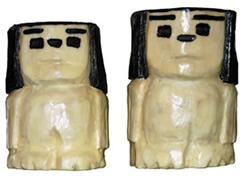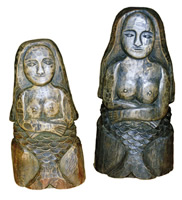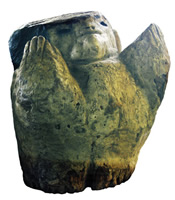 |
In the home of Sotera Sanchez da Silva and her son Mariano Antunes Cabral Silva, it’s easy to feel the presence of their famous ancestor, Conceição dos Bugres – a woman who, as if trying to get rid of evil spirits, used to sculpt “bugres” in pieces of wood and cover them in beeswax. “Bugre” is what people used to call native Indians and those of mixed race. And the beeswax was her way of trying to make them pale and beautiful.
Her grandson, Mariano, is proud of carrying on her work. His work follows the patterns of his grandmother’s. The difference is in the personality and in the feature of each bugre’s face. Mariano also sculpts other figurines as mystical as the bugres: mermaids.
Sotera, Conceição’s daughter-in-law, comes from Ponta-Porã (MS). Her accent reveals her ancestry, a mix of Guarani Indian and South American Spanish roots. Her husband got into woodcarving and so she started to get interested as well. “One day, I dreamed I was sculpting. I got up, made a drawing and started making a totem, something from my ancestors.”
In their house the two pillars that hold up the veranda are totems sculpted by Sotera, who has now started to make works using guava tree wood. She works as a waitress at the local University, and is proud of having one of her pieces in the gardens of the institution. |
 |
 |
TOTEM
Wood, 1.20 m tall.
Sotera Sanchez da Silva.
Private collection |
BUGRES
Wood covered in beeswax,
19 cm and 20 cm tall.
Sculptured by Mariano |
 |
 |
MERMAIDS
Wood, around 30 cm tall.
Sculptured by Mariano |
BRANCHES
Sculpture in guava tree branches,
around 1.60 m tall.
Sotera Sanchez da Silva |
|
| Conceição Freitas da Silva |
Conceição Freitas da Silva was born in the South, in Povinho de Santiago (RS), in 1914. A very charismatic woman, she arrived in Mato Grosso do Sul when still a child. She lived in Ponta Porã (MS) and in 1957 arrived in Campo Grande. She spent her life doing a bit of everything, and sharped pieces of wood as one would sharpen a pencil, only her tool was a small axe. By creating her bugres (Indians), she became known as Conceição dos Bugres.
She always covered her sculptures of Indians with beeswax. At first sight they seem to be made of stone. Lined up in a row they calmed the wild and disturbed soul of the artist. She would point out the differences between them. One looks up, the other sideways, another straight ahead – and in this way she baptized each one. She started making some with outstretched or half open arms, but those were few and today are considered rare. Conceição dos Bugres became famous, but never changed. She took part in exhibitions, won awards and her bugres have travelled the world. Perhaps out of need, or just for fun, her husband Anísio also started sculpting small bugres, just like hers.
The hard and hostile life of Conceição was filled with peace as she worked. The inhospitable was then transformed into simplicity and subtlety. Conceição dos Bugres passed away at 70 years of age. |
 |
 |
BUGRE
Wood and bitumen.
Sculptured by Conceição dos Bugres.
Arte Pantaneira Rubens Corrêa Museum collection,
Aquidauna, MS |
BUGRE
Wood covered in beeswax, 15 cm tall.
Sculptured by Anísio.
Rosilene Rosa’s collection, Aquidauana, MS |
|
|


